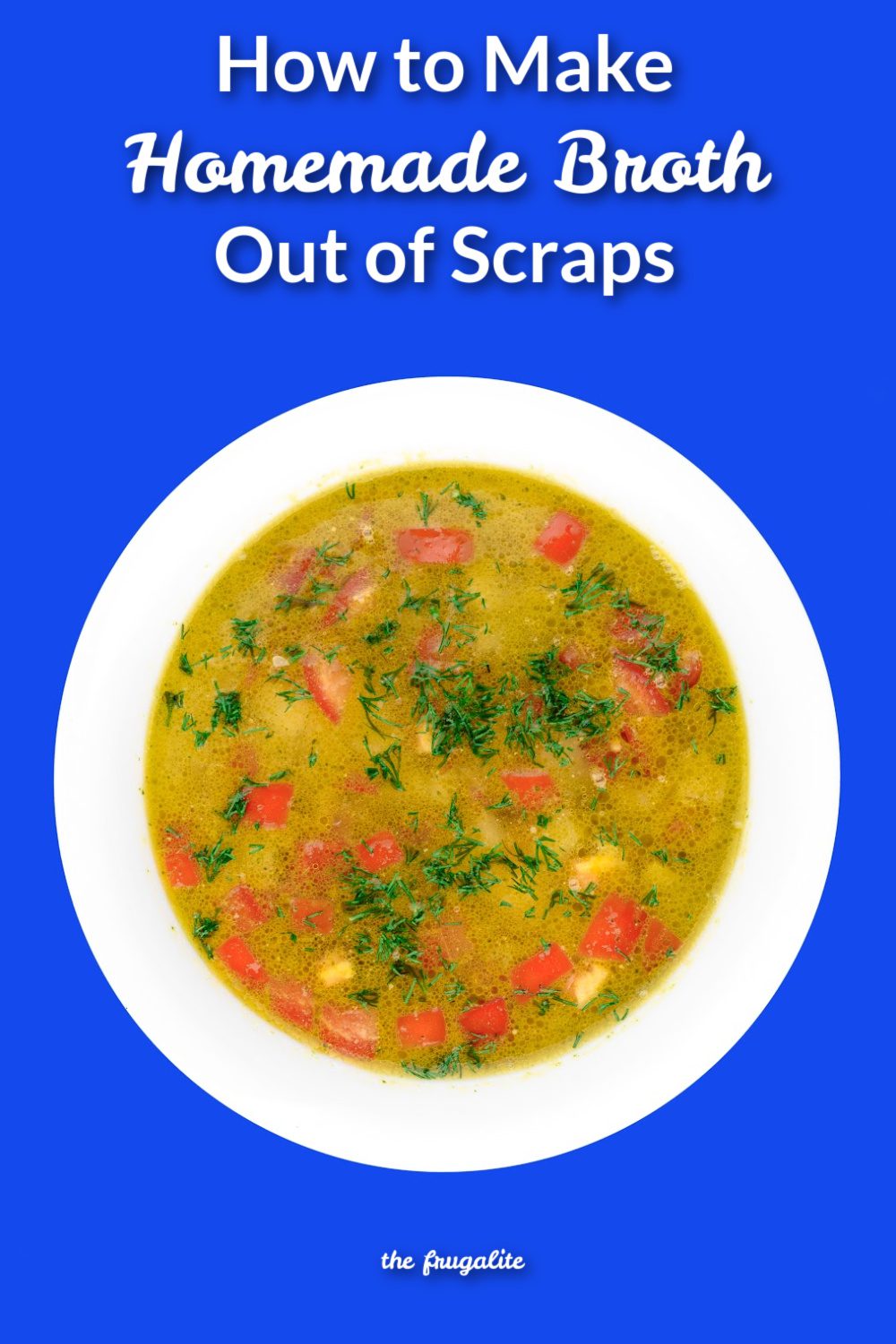(Psst: The FTC wants me to remind you that this website contains affiliate links. That means if you make a purchase from a link you click on, I might receive a small commission. This does not increase the price you’ll pay for that item nor does it decrease the awesomeness of the item. ~ Daisy)
I don’t usually dedicate an article, but this one I want to dedicate to my sister. She’s the one who taught me how to make homemade broth – an amazing life hack – and now I’m happy to share it with all of you.
Each year, in the USA alone, 108 billion pounds of food is wasted. In other words, over $4 billion worth of food. In fact, almost 40% of all food in America is wasted or thrown out. With numbers like that, no wonder most families are in debt and eating out regularly.
I admit, I throw out more food than I should. It’s something I’m working on. Thanks to my sister, it’s gotten easier. Also scraps we typically throw out after prepping our meals, my genius sister would save, freeze, and when she had enough stocked up, would boil them down into a broth.
What I do to make homemade broth
Food scraps. You know, the stuff you throw out after use finished prepping your vegetables? Peels, the ends, those bruises that you might not want to eat (even though they probably wouldn’t taste any different). Those are all key parts of homemade broth.
I’ve always done this with my chicken bones or if I had some leftover turkey bones after Thanksgiving, but I never thought about turning most of my scraps into soup broth. Boy, was I missing out, though.
So, I started saving mine up too and making broth on demand. Heck, I’m using the ends of onions, garlic peels, sweet potato peels, and chicken bones from the last chicken I bought to make broth even as I sit here writing this article.
So what’s involved?
Well, it’s simple. Just start saving your vegetable scraps (make sure you wash them first because you don’t want dirt in your broth). These are some of the things I save and ones I don’t:
Vegetable peels – Everything from potatoes and carrots, all the way to onions and garlic. If it’s a vegetable peel that otherwise would have been thrown out, I add it to my bag in the freezer.
Vegetable cores and ends – You know what I’m talking about, those little pieces of the vegetable that probably wouldn’t have bad flavor, but you wouldn’t want to eat by themselves. I’m talking the ends of onions that you cut off, the tops of carrots, the leaves of cauliflower – you get the idea.
Bones – With bones, you can do as little or as much as you would like. It doesn’t matter if they’re raw or cooked if you’re going to boil them down anyway. The great thing about using bones in your broth is it adds an extra boost of nutrients and healthy fat. Bone broth is known to be very healthy for you.
As for what bones I use, as long as I wasn’t directly gnawing on them (such as with ribs or chicken wings), I’ll save them in the freezer and turn them into broth later. One exception to this is if the bone is covered in sauce. Even then, I may just use it specifically for us to put that flavor into the broth. BBQ-flavored broth, anyone?
Salt – Now, this is a new requirement, but I do like salting my broth. I tend to put it in right at the beginning and let it simmer as the broth does.
So I’ve got my scraps. Now what?
Now, for the simple part! All you’re going to need is a pot and some water.
Simply put all of your food scraps in your pot, and fill it up with water. Put it on the stove, and bring it to a boil. Now, here’s the important part, you’re going to want to let it simmer for at least one hour. I tend to keep mine on medium-low for anywhere from 1 to 3 hours.
As it simmers, you’ll start to notice that the water will become darker and start to look like broth. (Be prepared for your house to smell absolutely amazing!) As the broth cooks, and the flavors of your vegetable and meat scraps soak into the water, the water level in the pot may go down. Well, it’ll probably go down. And that’s okay.
This is called reducing your broth.
It’s totally normal and totally fine. It really just means that the broth will be more flavorful. The more you reduce it, the thicker it will get as well. If you’ve got a lot of bones, reduce approximately 8 cups of water down to one, when it cools, it will be more gel-like. Kind of like cold gravy. Essentially, it’s the same thing. I like to think of it as a liquid-type form of a healthy bouillon cube from scratch.
The best part is that when you boil it down to a small amount, it takes up way less space. I like to boil mine down until it can fit into an ice cube tray, freeze it in independent little cubes, and then put it in a Ziploc bag. Then, when I need it, I can pull out 1 to 2 cubes and add them to my pot of water for soup and have perfect fresh instant soup broth.
Here’s another tip you may want to consider here…
If you are freezing your broth in an ice cube tray, let it cool down, so it’s only warm to room temperature, line the ice cube tray with plastic wrap, pushing it down in two each little ice cube spot, and then pour the broth in. Not only will this make it easier to pull the broth out after it’s been frozen, but it will also prevent the flavor of the broth from seeping into the plastic of your ice cube tray and tainting the flavor of everything you freeze in it going forward and staining the color of the tray.
Have you ever made homemade broth?
Have you ever made homemade broth? If not, you are really missing out. It makes a great and cheap base for soups, sauces, gravies, even down to cooking things in broth. (I love cooking my rice or potatoes in broth for an extra boost of flavor)
Do you do something different when you make your broth? What’s your favorite thing to add? Share in the comments below!
About Chloe Morgan
Chloe Morgan grew up living with a tight budget. In her late teens and early 20’s all the lessons she’d learned started to slip, like it does for many college age students on their own for the first time, and with their first credit card. As she’s gotten older, she’s started to deal with the repercussions and has taken on a frugal way of living, keeping her costs low, as she pays off debt and saves for her future. Chloe lives in Northern Ontario, Canada, with her cute dog, Rhea.












4 thoughts on “How to Make Homemade Broth Out of Scraps”
I loved that article! Store bought broth is expensive and this is free! I’ve never made homemade broth but I will now. I’m also going to ask the butcher for any beef bones he may have that he was going to throw away. I may also use my crock pot if I’m not planning on being home while it’s cooking. Thanks for sharing this great, frugal, and nutritious idea.
Great idea of asking the butcher for bones. My mom did this in the 1950s and 60s. “Oxtail Soup” was a regular on the menu in our home. Also the neck bones of a deer that you’ve harvested can make a very nutricious and tasty broth.
We have been doing that for years with our veggie scraps and chicken, beef and ham bones. A little advice. Take time to learn what flavor the veggies that you use adds to the broth, or you could get bitter or a flavor that may not be the best!
I have made homemade bone broth. It’s delicious and when you drink it as a soup, you can use it to fill your stomach (like drinking water) before a meal, filling you up so you eat less and help you lose weight but still getting your nutrition.
If you use beef bones, use knuckle bones with bone marrow and ox tails. These both have bone marrow. Also, soak these in some wine or some cider vinegar and grill them on low heat in the oven before adding them to the water. It adds flavor and the acid helps release the nutrients in the bones. Enjoy!